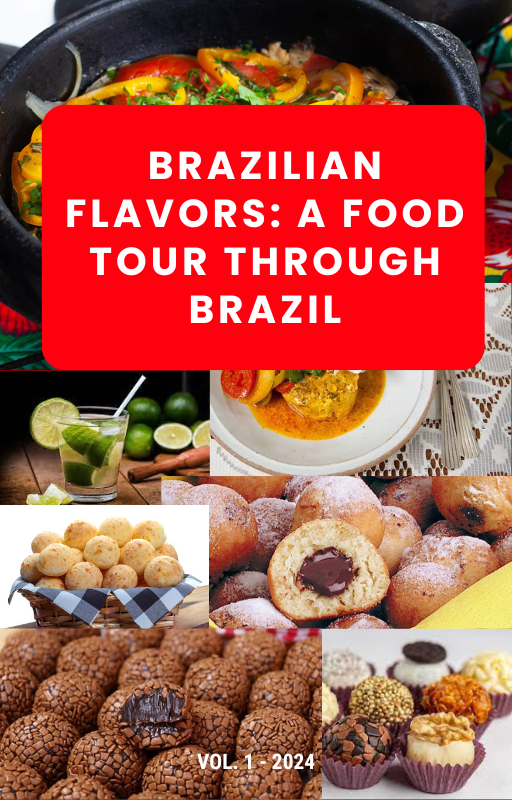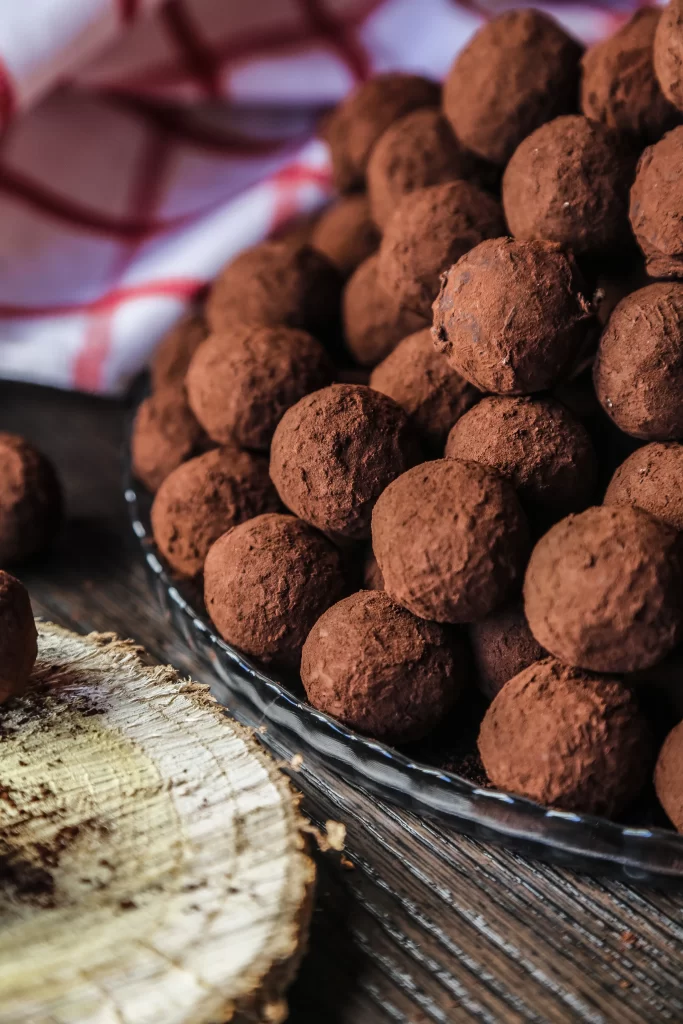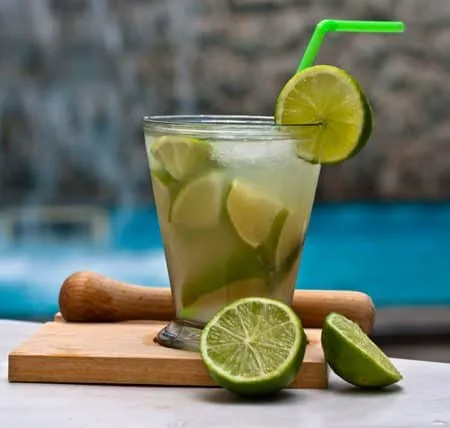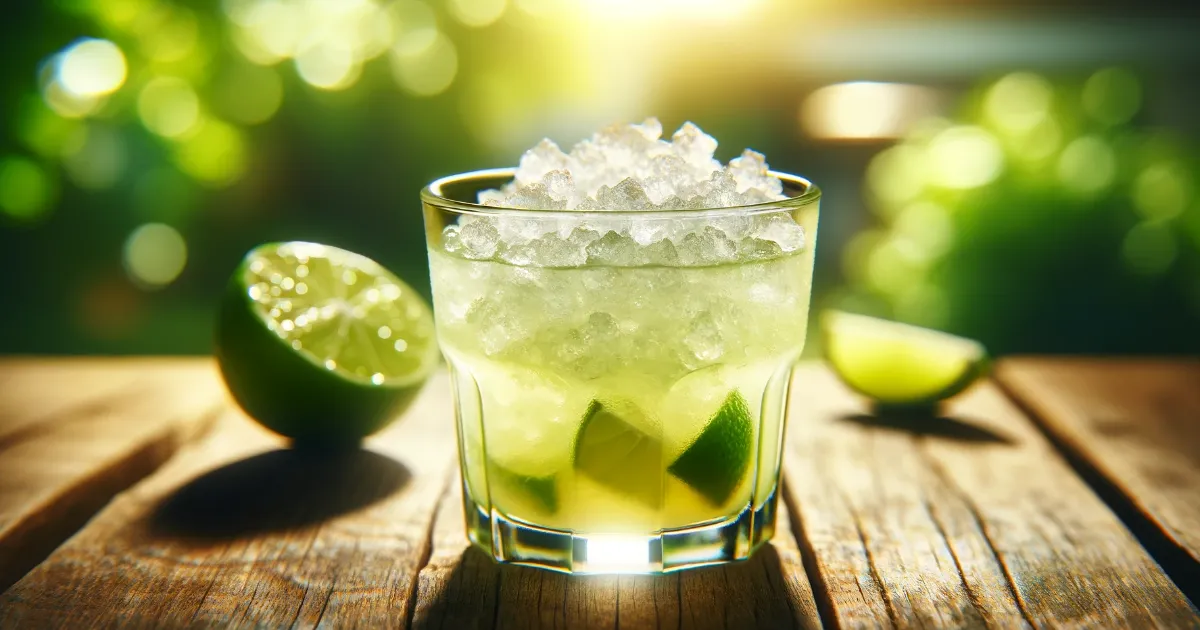Brazilian Flavors: a gastronomic tour through Brazil
Taste the authentic Brazilian flavor wherever you are!
Extended Promotional Value:
About the EBOOK:
The eBook "Brazilian Flavors: a gastronomic tour through Brazil" presents 11 recipes for savory dishes, 2 drinks and 4 traditional desserts from Brazilian culture and cuisine.
All recipes are detailed and adapted to international ingredients and measurements, with a clear step-by-step guide so that anyone can prepare them. The adaptations were made so that the original flavors remain in the recipes.
We hope that the delights of Brazilian dishes can brighten up your receptions and surprise your guests and family.
We are offering dishes from savory, for a different meal, on a special day, with our drinks, the famous caipirinha, and to end the moment, serve one of our delicious desserts.
Bon appétit!!

Why Buy the EBOOK?
- Discover the authentic flavors of Brazil, like Brazilians, even if you live outside Brazil
- Surprise your friends with dishes with striking and delicious flavors
- We bring the complete meal, from savory dishes, drinks and desserts, to surprise your guests
- Authentic Brazilian Recipes: Discover genuine recipes that bring the true taste of Brazil to your kitchen, carefully adapted to international ingredients.
- Detailed Step-by-Step: Each recipe comes with clear, easy-to-follow instructions, ensuring that even novice cooks can prepare delicious dishes.
- Easy to Find Ingredients: All recipes have been adapted to use ingredients that you can easily find abroad, without compromising the authentic taste.
- Cultural Exploration: In addition to cooking, you will learn about the rich Brazilian culture and the history behind each dish.
- Save Time and Money: Avoid the frustration of searching online for recipes that don't work. Our eBook offers tried and tested recipes that save you time and money.
- Impress Your Friends and Family: Surprise your loved ones with exotic and delicious dishes they have never tried before.
- Versatility in the Kitchen: Recipes in the eBook range from main dishes to desserts and drinks, offering a wide range of options for any occasion.
- Diet Adaptations: Recipes that can be easily adapted for different dietary needs, such as gluten-free or vegetarian.
- Health Benefits: Many Brazilian recipes use fresh and natural ingredients, contributing to a healthier diet.
- High-Quality Photographs: Each recipe is accompanied by high-quality photos, inspiring and guiding you every step of the way.
- Recipes for Every Level: Whether you're an experienced chef or new to the kitchen, our eBook has recipes to suit all skill levels.
- Support a Small Business: By purchasing this eBook, you are directly supporting a small business dedicated to sharing Brazilian culinary culture with the world.
- Convenient Digital Environment: Enjoy the convenience of a digital eBook that you can access from anywhere, at any time, on your tablet, smartphone or computer.
- Variety of Dishes: With 11 savory dishes, 2 drinks and 4 desserts, you will have a wide variety of options to choose from and impress.
- Satisfaction Guaranteed: We guarantee that you will love each recipe, bringing joy and flavor to your meals.
Ready to start your Brazilian gastronomic journey?
Don't miss your chance to explore the unique flavors of Brazil!!
Buy now the EBOOK "Brazilian Flavors: a gastronomic tour through Brazil, and take Brazilian cuisine to your home, and surprise your family and friends, with the explosion of flavors that our recipes bring!!
Promotional Value of Only $ 2.83 (US dollar base value)
At check-out there may be small variations in value, considering currency conversion.
17 recipes for just $ 2.83 (US dollar base value)
To test your taste buds and try one of the delights of Brazilian cuisine, we are offering a free gift, a free recipe for you to download. Right below!
Click on the arrow and access your gift
About the Recipes:
Each of the recipes included in the EBOOK brings a little piece of Brazilian history and culture, and its regions. History that begins with the discovery of Brazil and flavors brought by Europeans, Africans and other peoples who helped form today's Brazil.
Passionate about Brazilian cuisine, we seek to bring the authentic flavors of Brazil to the whole world.
We adapt the recipes to the measurements and ingredients, in order to maintain the original Brazilian flavors, so that you can experience Brazilianness wherever you are.
Common questions:
Are the recipes really easy to make?
- Yes, all recipes follow a detailed step-by-step guide, ideal for any skill level in the kitchen
Are the ingredients easy to find?
- Yes, all recipes have been adapted to use ingredients that you will easily find.
Is the EBOOK available in digital format?
- Yes, you can download the Ebook immediately after purchase.
Is a guarantee offered?
- Yes, the Hotmart portal offers a 7-day guarantee for possible returns, according to the site's policy.
What recipes will you find in the EBOOK?
Exclusive GIFT:
Here we present an original recipe, which is not included in the Ebook, so that you can have a small experience of Brazilian cuisine, completely FREE.
Click the button below and download a recipe for "Empadinha de Frango" or "chicken pie", a traditional Brazilian delicacy or snack, simply loved by everyone.
Don't miss this opportunity, and dive right into Brazilian cuisine. Click the button below and purchase the Ebook "Brazilian Flavors: A Food Tour Through Brasil"
Click now!!
Who is the Ebook for?
For those who are passionate about Brazilian cuisine, with its original flavors.
For those who want to surprise their family and friends with different, extremely tasty and aromatic dishes.
For those who wish to develop different dishes, but have no experience in the kitchen, and even for those who already have experience, but do not know Brazilian cuisine.
For those who have never made a Brazilian cuisine recipe. Our recipes are detailed step by step, and with ingredients adapted to your location.
For those who enjoy fun, tasty and challenging gastronomic experiences, with surprising results.
For those who want to try Brazilian food, drinks and desserts, without having to visit Brazil.
What will you find in the Ebook?
11 Recipes for savory dishes

Easy-to-execute recipes, following our step-by-step instructions.
Surprise your guests!
04 Dessert recipes

After enjoying a savory dish, there is nothing better than a delicious and easy-to-make dessert.
An explosion of life, in your mouth!
02 drink recipes

Learn how to make the most perfect Brazilian caipirinha.
Accompanied by a feijoada!!
Will I be able to execute these recipes without losing the original flavor of the dishes and drinks?
Yes! Our recipes are detailed, so that even people who are not experienced in the kitchen can arrive at the final dish, maintaining the original flavors.
In addition, the recipes have been adapted, in their ingredients and measurements, to your region.
Try and be a real Brazilian Chef.

Promotional value, don't miss it!!
Click on the items below, and learn a little about the history of each of the recipes in the Ebook
Arroz Carreteiro is a typical dish from the southern region of Brazil, particularly in the state of Rio Grande do Sul.
It has its origins among the tropeiros, who were traders who transported goods and livestock across the interior of the country.
This dish is made with rice and dried meat (jerky), ingredients that were easy to preserve during long journeys.
Carreteiro rice is an example of the rustic and practical cuisine of the Gauchos, reflecting country life and the culture of southern Brazil.
This is a classic combination on the Brazilian table, known as “prato done” or “PF”.
It consists of white rice, beans, acebolado steak (fried beef with onions) and a fried egg.
This dish represents the daily meal of many Brazilians and combines indigenous (beans), African (preparation methods) and Portuguese (rice and eggs) influences.
It is a simple, nutritious and very tasty meal, reflecting the essence of everyday Brazilian cuisine.
Bobó de Camarão is a traditional dish of Bahian cuisine, originating in the northeast region of Brazil.
It is made with shrimp, cassava (also known as cassava or cassava), coconut milk and dendê olive oil (palm oil).
This dish has African roots and was brought to Brazil by African slaves, who adapted their traditional recipes to local ingredients.
Bobó de Camarão is known for its creamy texture and exotic flavor, representing the rich mix of cultures in Bahia.
Coxinha is one of the most popular snacks in Brazil, very common at parties and cafeterias.
It is a dough made of wheat flour and potatoes, filled with shredded chicken, molded into the shape of a chicken thigh and fried until golden and crispy.
Legend says that coxinha was created in the 19th century to please Princess Isabel’s son.
This crunchy on the outside and juicy inside snack is a perfect example of Brazilian culinary creativity.
In Brazil, couscous varies greatly depending on the region. In the Northeast, it is made with corn flakes and usually served for breakfast with coconut milk or sun-dried meat.
In the Southeast, especially in São Paulo, São Paulo couscous is a savory pie made with corn flour, vegetables, chicken or fish.
Couscous was brought to Brazil by Portuguese colonizers, who adapted the North African recipe to local ingredients.
This dish demonstrates the diversity and adaptability of Brazilian cuisine.
Feijão Tropeiro is a traditional recipe from Minas Gerais, a central region of Brazil.
It has its roots in the times of the tropeiros, who were traders and explorers who traveled through the interior of the country.
The dish is made with beans, cassava flour, sausage, bacon and eggs, creating a substantial meal full of flavor.
Feijão Tropeiro is a reflection of the rustic and nutritious cuisine of the tropeiros, who needed energy for their long journeys.
Feijoada is one of Brazil’s most iconic dishes, typically served on Wednesdays and Saturdays.
It consists of a black bean stew with a variety of pork meats, including sausage and pieces of salted beef.
The feijoada is accompanied by rice, braised cabbage and orange.
Feijoada is believed to have its origins in slave quarters, where African slaves created this nutritious dish with leftover meat.
Today, feijoada is a celebration of the mix of cultures and is loved throughout Brazil.
Moqueca de Peixe is a traditional dish from the coastal regions of Brazil, especially Bahia and Espírito Santo.
It is a stew made with fish, tomatoes, onions, peppers, coconut milk and palm oil, cooked slowly in a clay pot.
Moqueca has its roots in indigenous cuisine, enriched by African and Portuguese influences.
This dish is known for its rich flavor and exotic aroma, representing Brazil’s cultural diversity.
Pão de Queijo is a traditional snack from Minas Gerais, a region in southeastern Brazil.
Made with cassava starch, cheese and eggs, it is crunchy on the outside and soft on the inside.
The origin of cheese bread dates back to the colonial period, when slaves adapted European recipes with available ingredients, such as cassava.
Today, cheese bread is a symbol of Minas Gerais hospitality and is loved throughout Brazil.
Virado à Paulista is a typical dish from the state of São Paulo, traditionally served on Mondays.
It includes cooked beans mixed with cassava flour, pork, rice, cabbage and fried egg.
This dish has its origins in the cuisine of the bandeirantes, explorers of the interior of Brazil in the 17th century.
Adapted over the years, Virado à Paulista represents the mix of country and Portuguese cultures, adapted to the routine of São Paulo workers.
Arroz Carreteiro is a typical dish from the southern region of Brazil, particularly in the state of Rio Grande do Sul.
It has its origins among the tropeiros, who were traders who transported goods and livestock across the interior of the country.
This dish is made with rice and dried meat (jerky), ingredients that were easy to preserve during long journeys.
Carreteiro rice is an example of the rustic and practical cuisine of the Gauchos, reflecting country life and the culture of southern Brazil.
Caipirinha is Brazil’s most famous drink, made with cachaça (a Brazilian sugarcane distillate), lemon, sugar and ice.
Originating in São Paulo at the beginning of the 20th century, the caipirinha was initially used as a remedy for colds and flu.
The combination of cachaça, lemon and sugar created a refreshing drink that became popular around the world, symbolizing the festive and joyful spirit of Brazilians.
Green corn juice is a typical drink of June festivals, traditional Brazilian celebrations.
Made with fresh corn, milk, sugar and cinnamon, this juice has a creamy texture and a sweet, comforting flavor.
It represents the simplicity and richness of Brazilian agricultural traditions, being an example of how corn is a versatile and essential ingredient in Brazilian cuisine.
Rain cakes are small fried dumplings, sprinkled with sugar and cinnamon, typical of rainy afternoons.
Associated with grandmothers’ recipes, these simple sweets originate in Portugal and were brought to Brazil by colonizers.
Adapted to local ingredients, dumplings have become a nostalgic dessert, bringing to mind childhood times and the simplicity of homemade Brazilian cuisine.
Brigadeiro is an essential sweet at Brazilian birthday parties.
Made with condensed milk, chocolate and butter, it is rolled into balls and covered with chocolate sprinkles.
The brigadeiro appeared in the 1940s, during the presidential campaign of Brigadeiro Eduardo Gomes, and quickly became popular.
This sweet symbolizes the joy of Brazilian celebrations and is loved by people of all ages.
Milk pudding is a classic Brazilian dessert, similar to flan.
Made with condensed milk, milk, eggs and caramelized sugar, the pudding has a smooth texture and delicate flavor.
Its origins date back to the Portuguese influence on Brazilian cuisine, with adaptations that have made it one of the most beloved desserts in the country.
It is enjoyed on many occasions and is known for its simplicity and flavor.
Tamale is a delicacy made from corn, traditional in Brazilian June festivals.
Wrapped in corn straw, the tamale can be sweet or savory, filled with cheese, meat or coconut.
Originating from indigenous cuisine, pamonha was incorporated into Brazilian culture with African and Portuguese influences.
This dish celebrates the corn harvest and is an example of the richness and diversity of Brazil’s culinary traditions.